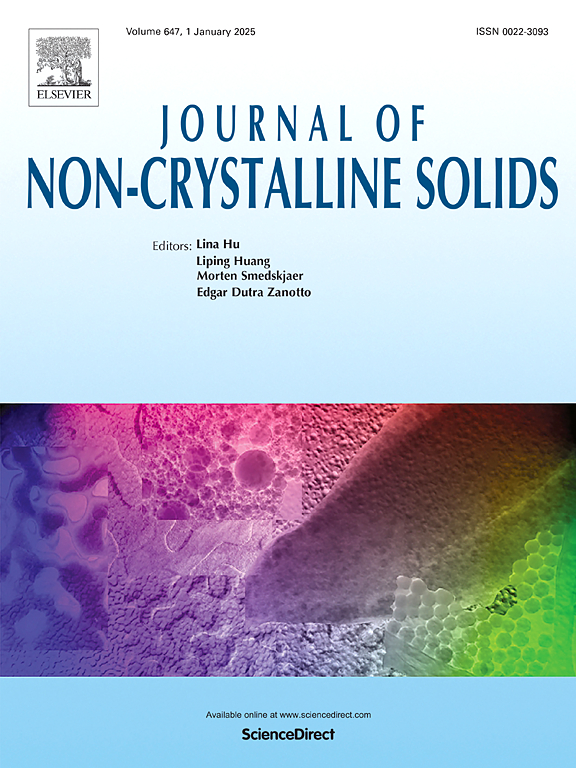Effects of CaF2 addition on the structure, optical properties, and chemical durability of phosphate glasses
IF 3.2
3区 材料科学
Q1 MATERIALS SCIENCE, CERAMICS
引用次数: 0
Abstract
A series of aluminum phosphate glasses doped with 0.01 copper oxide (CuO) has been prepared by the melting-quench method. Calcium fluoride (CaF₂) was introduced as a network modifier, partially substituting phosphate (P₂O₅), to examine its effects on structural, thermal, chemical, and optical properties. Thermal Mechanical Analysis (TMA) results indicate that CaF₂ incorporation reduces the glass transition temperature (Tg) from 623 °C to 599 °C. X-ray diffraction (XRD) identify samples were amorphous. Structural analyses using Nuclear Magnetic Resonance (NMR), Fourier-transform infrared spectroscopy (FTIR), and X-ray photoelectron spectroscopy (XPS) confirmed the formation of (PO₃)-F terminal bonds, resulting in improved chemical durability through the reduction of P–OH bond formation. Furthermore, UV–visible spectroscopy revealed that the addition of CaF₂ increases the optical band gap associated with copper ions from 3.71 eV to 3.95 eV. This study demonstrates that incorporating up to 0.0792 CaF₂ enhances the chemical durability of phosphate glasses by approximately 20 %, suggesting potential benefits for developing stronger and more efficient optical materials.
CaF2添加对磷酸盐玻璃结构、光学性能和化学耐久性的影响
采用熔融淬火法制备了掺杂0.01氧化铜的磷酸铝玻璃。引入氟化钙(CaF₂)作为网络改性剂,部分取代磷酸盐(P₂O₅),以研究其对结构,热,化学和光学性能的影响。热力学分析(TMA)结果表明,CaF 2的掺入使玻璃化转变温度(Tg)从623℃降至599℃。x射线衍射(XRD)鉴定样品为无定形。使用核磁共振(NMR)、傅里叶变换红外光谱(FTIR)和x射线光电子能谱(XPS)的结构分析证实了(PO₃)-F末端键的形成,通过减少P-OH键的形成,从而提高了化学耐久性。此外,紫外可见光谱显示,CaF 2的加入使与铜离子相关的光学带隙从3.71 eV增加到3.95 eV。该研究表明,加入高达0.0792 CaF 2可使磷酸盐玻璃的化学耐久性提高约20%,这表明开发更强,更高效的光学材料的潜在好处。
本文章由计算机程序翻译,如有差异,请以英文原文为准。
求助全文
约1分钟内获得全文
求助全文
来源期刊

Journal of Non-crystalline Solids
工程技术-材料科学:硅酸盐
CiteScore
6.50
自引率
11.40%
发文量
576
审稿时长
35 days
期刊介绍:
The Journal of Non-Crystalline Solids publishes review articles, research papers, and Letters to the Editor on amorphous and glassy materials, including inorganic, organic, polymeric, hybrid and metallic systems. Papers on partially glassy materials, such as glass-ceramics and glass-matrix composites, and papers involving the liquid state are also included in so far as the properties of the liquid are relevant for the formation of the solid.
In all cases the papers must demonstrate both novelty and importance to the field, by way of significant advances in understanding or application of non-crystalline solids; in the case of Letters, a compelling case must also be made for expedited handling.
 求助内容:
求助内容: 应助结果提醒方式:
应助结果提醒方式:


